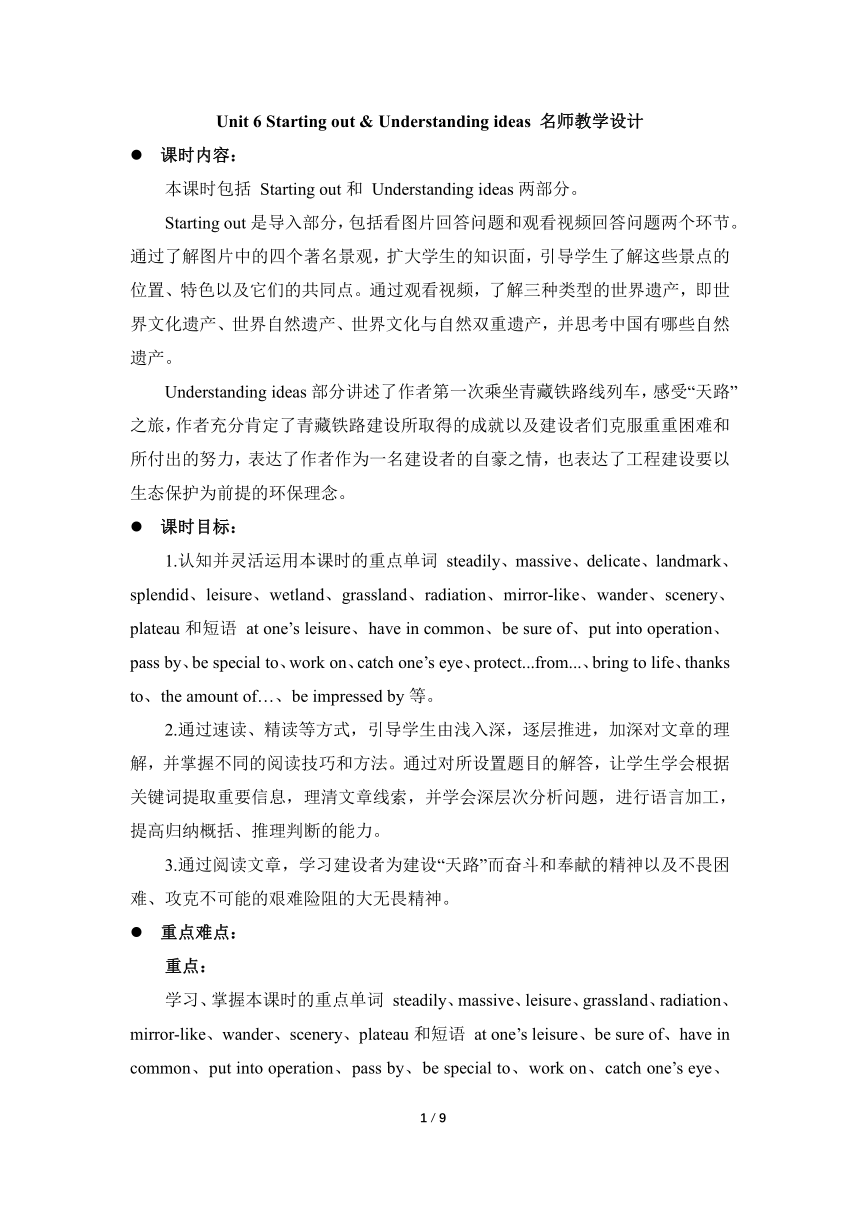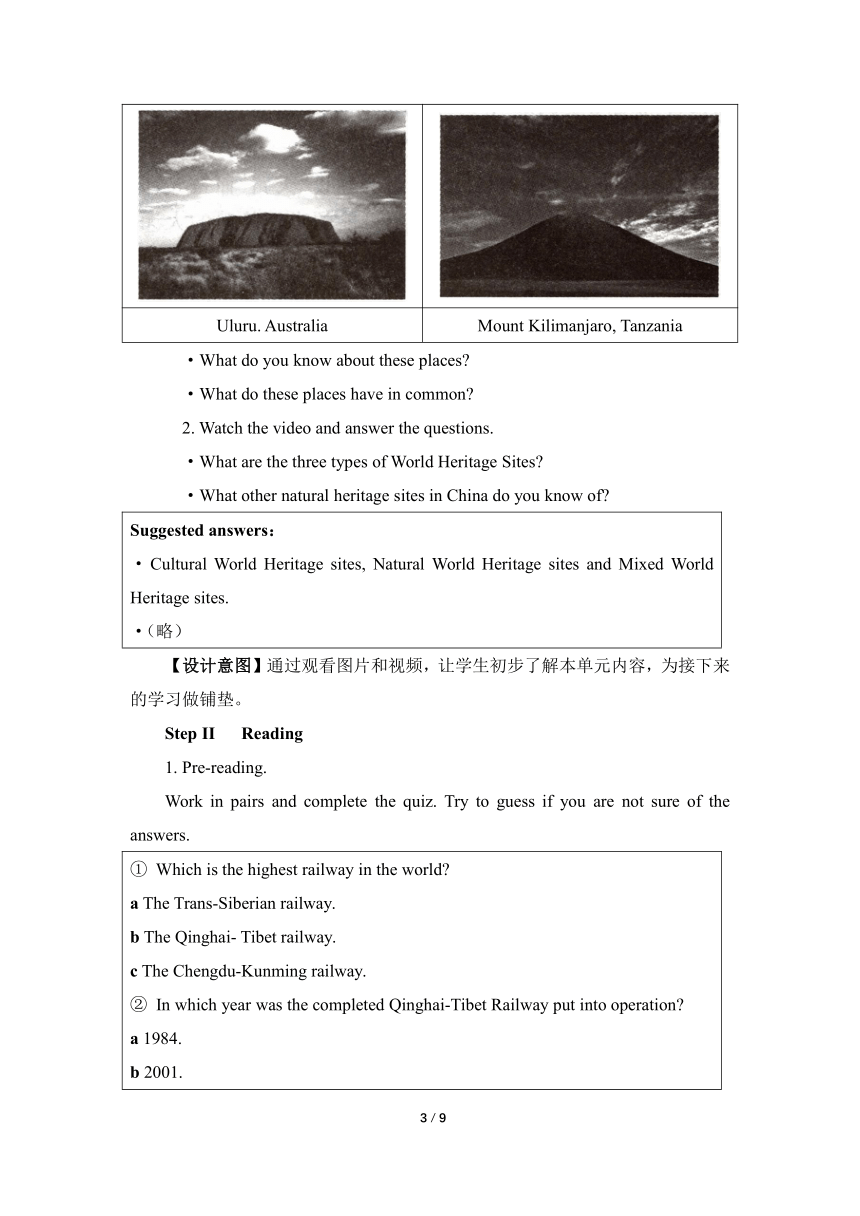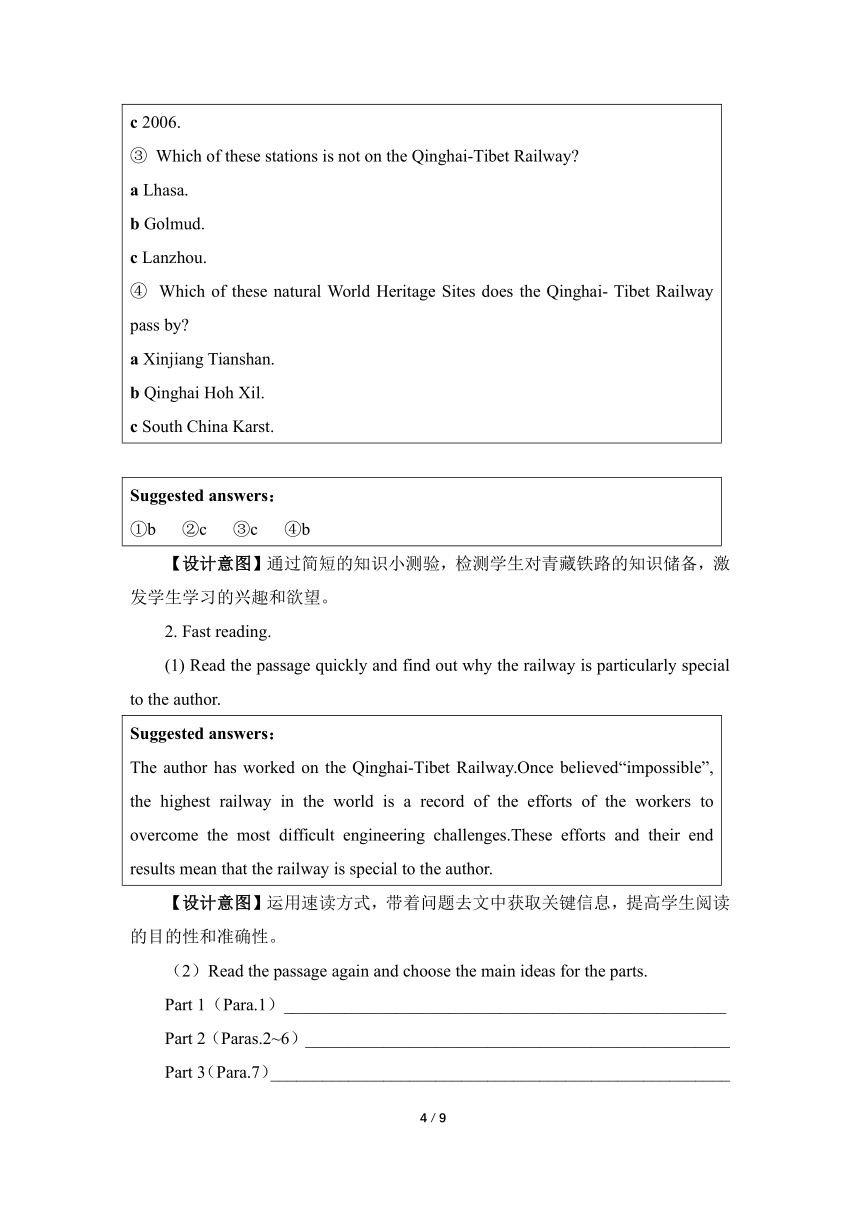外研版(2019)高中英语选择性必修第一册 Unit6 Nurturing nature Starting out and Understanding ideas 名师教学设计
文档属性
| 名称 | 外研版(2019)高中英语选择性必修第一册 Unit6 Nurturing nature Starting out and Understanding ideas 名师教学设计 |  | |
| 格式 | docx | ||
| 文件大小 | 1.7MB | ||
| 资源类型 | 教案 | ||
| 版本资源 | 外研版(2019) | ||
| 科目 | 英语 | ||
| 更新时间 | 2023-03-02 21:04:26 | ||
图片预览




文档简介
Unit 6 Starting out & Understanding ideas 名师教学设计
课时内容:
本课时包括 Starting out和 Understanding ideas两部分。
Starting out是导入部分,包括看图片回答问题和观看视频回答问题两个环节。通过了解图片中的四个著名景观,扩大学生的知识面,引导学生了解这些景点的位置、特色以及它们的共同点。通过观看视频,了解三种类型的世界遗产,即世界文化遗产、世界自然遗产、世界文化与自然双重遗产,并思考中国有哪些自然遗产。
Understanding ideas部分讲述了作者第一次乘坐青藏铁路线列车,感受“天路”之旅,作者充分肯定了青藏铁路建设所取得的成就以及建设者们克服重重困难和所付出的努力,表达了作者作为一名建设者的自豪之情,也表达了工程建设要以生态保护为前提的环保理念。
课时目标:
1.认知并灵活运用本课时的重点单词 steadily、massive、delicate、landmark、splendid、leisure、wetland、grassland、radiation、mirror-like、wander、scenery、plateau和短语 at one’s leisure、have in common、be sure of、put into operation、pass by、be special to、work on、catch one’s eye、protect...from...、bring to life、thanks to、the amount of…、be impressed by等。
2.通过速读、精读等方式,引导学生由浅入深,逐层推进,加深对文章的理解,并掌握不同的阅读技巧和方法。通过对所设置题目的解答,让学生学会根据关键词提取重要信息,理清文章线索,并学会深层次分析问题,进行语言加工,提高归纳概括、推理判断的能力。
3.通过阅读文章,学习建设者为建设“天路”而奋斗和奉献的精神以及不畏困难、攻克不可能的艰难险阻的大无畏精神。
重点难点:
重点:
学习、掌握本课时的重点单词 steadily、massive、leisure、grassland、radiation、mirror-like、wander、scenery、plateau和短语 at one’s leisure、be sure of、have in common、put into operation、pass by、be special to、work on、catch one’s eye、protect…from…、bring to life、thanks to、the amount of...、be impressed by等,并能在具体语境中灵活运用。
难点:
1.通过解决阅读阶段所设置的题目,学会分析问题、解决问题,理清文章脉络,提高阅读水平。
2.通过阅读文章,学会观察,提高分析问题、思考问题、解决问题的能力。
教学准备:
教师准备:
1.准备好该部分内容的视频材料、PPT以及音频素材。
2.设计好阅读理解题目,利用不同方式拓展语言点,激发学生兴趣。
学生准备:
1.在网上搜索课本中提到的四个中外著名自然景观:中国的黄龙风景名胜区、阿根廷与巴西交界处的伊瓜苏瀑布、坦桑尼亚的乞力马扎罗山和澳大利亚的乌卢鲁巨石的相关信息,并找出它们的共同点。
2.了解有关“天路”的更多背景信息。
3.预习 Starting out和 Understanding ideas两部分内容,通过查字典等方式提前解决词汇问题。
教学过程:
Step I Starting out
1. Look at the pictures and answer the questions.
Huanglong, China Iguazú Falls, Argentina and Brazil
Uluru. Australia Mount Kilimanjaro, Tanzania
·What do you know about these places
·What do these places have in common
2. Watch the video and answer the questions.
·What are the three types of World Heritage Sites
·What other natural heritage sites in China do you know of
Suggested answers: ·Cultural World Heritage sites, Natural World Heritage sites and Mixed World Heritage sites. ·(略)
【设计意图】通过观看图片和视频,让学生初步了解本单元内容,为接下来的学习做铺垫。
Step II Reading
1. Pre-reading.
Work in pairs and complete the quiz. Try to guess if you are not sure of the answers.
① Which is the highest railway in the world a The Trans-Siberian railway. b The Qinghai- Tibet railway. c The Chengdu-Kunming railway. ② In which year was the completed Qinghai-Tibet Railway put into operation a 1984. b 2001. c 2006. ③ Which of these stations is not on the Qinghai-Tibet Railway a Lhasa. b Golmud. c Lanzhou. ④ Which of these natural World Heritage Sites does the Qinghai- Tibet Railway pass by a Xinjiang Tianshan. b Qinghai Hoh Xil. c South China Karst.
Suggested answers: ①b ②c ③c ④b
【设计意图】通过简短的知识小测验,检测学生对青藏铁路的知识储备,激发学生学习的兴趣和欲望。
2. Fast reading.
(1) Read the passage quickly and find out why the railway is particularly special to the author.
Suggested answers: The author has worked on the Qinghai-Tibet Railway.Once believed“impossible”, the highest railway in the world is a record of the efforts of the workers to overcome the most difficult engineering challenges.These efforts and their end results mean that the railway is special to the author.
【设计意图】运用速读方式,带着问题去文中获取关键信息,提高学生阅读的目的性和准确性。
(2)Read the passage again and choose the main ideas for the parts.
Part 1(Para.1)___________________________________________________
Part 2(Paras.2~6)_________________________________________________
Part 3(Para.7)_____________________________________________________
A. How the workers protect the delicate ecosystem. B. I’m proud that we built our “impossible” railway with the care that the environment deserves. C. I’m about to travel along the railway that many foreign experts claimed was“impossible”.
Suggested answers: Part 1: C; Part 2: A; Part 3: B
【设计意图】通过该活动,引导学生理清段落大意,了解整篇文章的布局结构,有助于提高学生的概括、分析能力。
3.Careful reading.
(1) Read the passage and choose the best answers.
①According to many foreign experts ,_______. A. it would take a few years to build the railway B. it would need a lot of machines to build the railway C. only foreign companies could complete the task D. it was impossible to build the railway ② What can we infer from the second paragraph A. It took the workers less than a year to complete the railway. B. The author was among the construction workers of the Qinghai-Tibet railway. C. The construction workers paid no attention to ecosystem protection while building the railway. D. The construction workers didn’t encounter the challenges foreign experts had expected. ③ Why were 675 bridges with a total length of about 160 kilometres built between Golmud and Lhasa A. To protect wild animals B. To make sure the workers stayed healthy C. To protect Cuona Lake from construction waste. D. To prevent damage to wetlands and grasslands. ④ Which of the following is NOT true according to the passage A. The railway starts with Xining, the capital of Qinghai. B. Located at over 5, 000 metres above sea level ,Lhasa Station is the highest railway station in the world. C. The Qinghai-Tibet Plateau is referred to as the“roof of the world”. D. Thousands and thousands of sandbags were used to protect Cuona Lake.
Suggested answers: ①D ②B ③D ④B
(2) Language points.
Master the words and phrases:
steadily, massive, leisure, grassland, radiation, mirror-like,wander,scenery,plateau,at one’s leisure, be sure of,have in common,put into operation,pass by,be special to,work on,catch one’s eye,protect…from…,bring to life,thanks to,the amount of...,be impressed by
【备注】词汇知识点讲解详见第二教案“新知探究”。
(3)Read the passage again and retell it.
【设计意图】通过设置一系列活动,引导学生进一步理解文章,吃透教材,从不同侧面加深对文章的理解,培养学生分析题目、把握题干和选项中的各种信息、找准关键词、回扣原文、归纳出正确答案的能力。
4.Post-reading.
(1) Do Activity 3 on Page 64.
Choose the author’s purpose in writing the passage and give your reasons.
① To prove that humans can conquer nature.
② To highlight the amount of work required to build the Qinghai-Tibet Railway.
③ To praise the workers’ efforts in building the Qinghai-Tibet Railway.
Suggested answers: ③
【设计意图】该活动以选择题的形式呈现,让学生选出作者的写作意图,锻炼学生获取关键信息、归纳总结的能力。
(2)Do Activity 4 on Page 64.
Organise information from the passage and complete the table.
Challenges Solutions
To protect wild animals. ·①_____________have been built under the railway to allow the animals to ②____________.
To ③____________. ·675 bridges with④____________were built between Golmud and Lhasa. ·140,000 square metres of wetland were⑤____________ in order to protect its distinct ecosystem.
To make sure the workers stayed healthy. ·⑥_____________were constructed. ·The workers also enjoyed ⑦_____________in lower areas.
To ⑧____________. ·Thousands and thousands of sandbags were used to⑨_____________along the lake to ⑩_____________.
Suggested answers: ① Thirty-three passages ② move safely and freely in their natural habitat ③ prevent damage to wetlands and grasslands ④ a total length of about 160 kilometres ⑤ moved to a new area ⑥ several oxygen-making stations ⑦ regular breaks ⑧ protect Cuona Lake ⑨ build a twenty-kilometre wall ⑩ protect it from construction waste
【设计意图】通过表格的形式,将建设青藏铁路所面临的问题以及解决方案清晰地列出来,有助于学生理清文章主线、获取关键信息。引导学生抓住题目中的关键词,回扣原文,通过原文定位法,找到问题的答案。
Step Ⅲ Summing up
总结本节课的重点单词 steadily、massive、leisure、grassland、radiation、mirror-like、wander、scenery、plateau和短语 at one’s leisure、be sure of、have in common、put into operation、pass by、be special to、work on、catch one’s eye、protect…from…、bring to life、thanks to、the amount of…、be impressed by以及句型,采用表格、思维导图等形式更清晰地了解它们的用法,形成知识脉络。
2.让学生简要概括建设青藏铁路面临的困难以及解决方法,进一步锻炼学生概括、归纳的能力。
3.通过对建设者们建设青藏铁路所付出的超于常人的努力的了解,学习他们克服困难、积极寻找解决问题的途径并为之奋斗的精神。
Step IV Homework
1. Sum up what you learned in class and take notes.
2. Preview the next period.
板书设计
Unit 6 Nurturing nature Period I Starting out & Understanding ideas I. Starting out 1. Look at the pictures and answer the questions. ·What do you know about these places ·What do these places have in common 2. Watch the video and answer the questions. ·What are the three types of World Heritage Sites ·What other natural heritage sites in China do you know of Ⅱ. Reading 1. Pre-reading. Work in pairs and complete the quiz. 2. Fast reading. (1) Read the passage quickly and find out why the railway is particularly special to the author. (2) Read the passage again and choose the main ideas for the parts. 3. Careful reading. (1) Read the passage and choose the best answers. (2) Language points. (3) Read the passage again and retell it. 4. Post-reading. Do Activities 3 and 4 on Page 64. Ⅲ. Summing up Ⅳ. Homework
2 / 2
课时内容:
本课时包括 Starting out和 Understanding ideas两部分。
Starting out是导入部分,包括看图片回答问题和观看视频回答问题两个环节。通过了解图片中的四个著名景观,扩大学生的知识面,引导学生了解这些景点的位置、特色以及它们的共同点。通过观看视频,了解三种类型的世界遗产,即世界文化遗产、世界自然遗产、世界文化与自然双重遗产,并思考中国有哪些自然遗产。
Understanding ideas部分讲述了作者第一次乘坐青藏铁路线列车,感受“天路”之旅,作者充分肯定了青藏铁路建设所取得的成就以及建设者们克服重重困难和所付出的努力,表达了作者作为一名建设者的自豪之情,也表达了工程建设要以生态保护为前提的环保理念。
课时目标:
1.认知并灵活运用本课时的重点单词 steadily、massive、delicate、landmark、splendid、leisure、wetland、grassland、radiation、mirror-like、wander、scenery、plateau和短语 at one’s leisure、have in common、be sure of、put into operation、pass by、be special to、work on、catch one’s eye、protect...from...、bring to life、thanks to、the amount of…、be impressed by等。
2.通过速读、精读等方式,引导学生由浅入深,逐层推进,加深对文章的理解,并掌握不同的阅读技巧和方法。通过对所设置题目的解答,让学生学会根据关键词提取重要信息,理清文章线索,并学会深层次分析问题,进行语言加工,提高归纳概括、推理判断的能力。
3.通过阅读文章,学习建设者为建设“天路”而奋斗和奉献的精神以及不畏困难、攻克不可能的艰难险阻的大无畏精神。
重点难点:
重点:
学习、掌握本课时的重点单词 steadily、massive、leisure、grassland、radiation、mirror-like、wander、scenery、plateau和短语 at one’s leisure、be sure of、have in common、put into operation、pass by、be special to、work on、catch one’s eye、protect…from…、bring to life、thanks to、the amount of...、be impressed by等,并能在具体语境中灵活运用。
难点:
1.通过解决阅读阶段所设置的题目,学会分析问题、解决问题,理清文章脉络,提高阅读水平。
2.通过阅读文章,学会观察,提高分析问题、思考问题、解决问题的能力。
教学准备:
教师准备:
1.准备好该部分内容的视频材料、PPT以及音频素材。
2.设计好阅读理解题目,利用不同方式拓展语言点,激发学生兴趣。
学生准备:
1.在网上搜索课本中提到的四个中外著名自然景观:中国的黄龙风景名胜区、阿根廷与巴西交界处的伊瓜苏瀑布、坦桑尼亚的乞力马扎罗山和澳大利亚的乌卢鲁巨石的相关信息,并找出它们的共同点。
2.了解有关“天路”的更多背景信息。
3.预习 Starting out和 Understanding ideas两部分内容,通过查字典等方式提前解决词汇问题。
教学过程:
Step I Starting out
1. Look at the pictures and answer the questions.
Huanglong, China Iguazú Falls, Argentina and Brazil
Uluru. Australia Mount Kilimanjaro, Tanzania
·What do you know about these places
·What do these places have in common
2. Watch the video and answer the questions.
·What are the three types of World Heritage Sites
·What other natural heritage sites in China do you know of
Suggested answers: ·Cultural World Heritage sites, Natural World Heritage sites and Mixed World Heritage sites. ·(略)
【设计意图】通过观看图片和视频,让学生初步了解本单元内容,为接下来的学习做铺垫。
Step II Reading
1. Pre-reading.
Work in pairs and complete the quiz. Try to guess if you are not sure of the answers.
① Which is the highest railway in the world a The Trans-Siberian railway. b The Qinghai- Tibet railway. c The Chengdu-Kunming railway. ② In which year was the completed Qinghai-Tibet Railway put into operation a 1984. b 2001. c 2006. ③ Which of these stations is not on the Qinghai-Tibet Railway a Lhasa. b Golmud. c Lanzhou. ④ Which of these natural World Heritage Sites does the Qinghai- Tibet Railway pass by a Xinjiang Tianshan. b Qinghai Hoh Xil. c South China Karst.
Suggested answers: ①b ②c ③c ④b
【设计意图】通过简短的知识小测验,检测学生对青藏铁路的知识储备,激发学生学习的兴趣和欲望。
2. Fast reading.
(1) Read the passage quickly and find out why the railway is particularly special to the author.
Suggested answers: The author has worked on the Qinghai-Tibet Railway.Once believed“impossible”, the highest railway in the world is a record of the efforts of the workers to overcome the most difficult engineering challenges.These efforts and their end results mean that the railway is special to the author.
【设计意图】运用速读方式,带着问题去文中获取关键信息,提高学生阅读的目的性和准确性。
(2)Read the passage again and choose the main ideas for the parts.
Part 1(Para.1)___________________________________________________
Part 2(Paras.2~6)_________________________________________________
Part 3(Para.7)_____________________________________________________
A. How the workers protect the delicate ecosystem. B. I’m proud that we built our “impossible” railway with the care that the environment deserves. C. I’m about to travel along the railway that many foreign experts claimed was“impossible”.
Suggested answers: Part 1: C; Part 2: A; Part 3: B
【设计意图】通过该活动,引导学生理清段落大意,了解整篇文章的布局结构,有助于提高学生的概括、分析能力。
3.Careful reading.
(1) Read the passage and choose the best answers.
①According to many foreign experts ,_______. A. it would take a few years to build the railway B. it would need a lot of machines to build the railway C. only foreign companies could complete the task D. it was impossible to build the railway ② What can we infer from the second paragraph A. It took the workers less than a year to complete the railway. B. The author was among the construction workers of the Qinghai-Tibet railway. C. The construction workers paid no attention to ecosystem protection while building the railway. D. The construction workers didn’t encounter the challenges foreign experts had expected. ③ Why were 675 bridges with a total length of about 160 kilometres built between Golmud and Lhasa A. To protect wild animals B. To make sure the workers stayed healthy C. To protect Cuona Lake from construction waste. D. To prevent damage to wetlands and grasslands. ④ Which of the following is NOT true according to the passage A. The railway starts with Xining, the capital of Qinghai. B. Located at over 5, 000 metres above sea level ,Lhasa Station is the highest railway station in the world. C. The Qinghai-Tibet Plateau is referred to as the“roof of the world”. D. Thousands and thousands of sandbags were used to protect Cuona Lake.
Suggested answers: ①D ②B ③D ④B
(2) Language points.
Master the words and phrases:
steadily, massive, leisure, grassland, radiation, mirror-like,wander,scenery,plateau,at one’s leisure, be sure of,have in common,put into operation,pass by,be special to,work on,catch one’s eye,protect…from…,bring to life,thanks to,the amount of...,be impressed by
【备注】词汇知识点讲解详见第二教案“新知探究”。
(3)Read the passage again and retell it.
【设计意图】通过设置一系列活动,引导学生进一步理解文章,吃透教材,从不同侧面加深对文章的理解,培养学生分析题目、把握题干和选项中的各种信息、找准关键词、回扣原文、归纳出正确答案的能力。
4.Post-reading.
(1) Do Activity 3 on Page 64.
Choose the author’s purpose in writing the passage and give your reasons.
① To prove that humans can conquer nature.
② To highlight the amount of work required to build the Qinghai-Tibet Railway.
③ To praise the workers’ efforts in building the Qinghai-Tibet Railway.
Suggested answers: ③
【设计意图】该活动以选择题的形式呈现,让学生选出作者的写作意图,锻炼学生获取关键信息、归纳总结的能力。
(2)Do Activity 4 on Page 64.
Organise information from the passage and complete the table.
Challenges Solutions
To protect wild animals. ·①_____________have been built under the railway to allow the animals to ②____________.
To ③____________. ·675 bridges with④____________were built between Golmud and Lhasa. ·140,000 square metres of wetland were⑤____________ in order to protect its distinct ecosystem.
To make sure the workers stayed healthy. ·⑥_____________were constructed. ·The workers also enjoyed ⑦_____________in lower areas.
To ⑧____________. ·Thousands and thousands of sandbags were used to⑨_____________along the lake to ⑩_____________.
Suggested answers: ① Thirty-three passages ② move safely and freely in their natural habitat ③ prevent damage to wetlands and grasslands ④ a total length of about 160 kilometres ⑤ moved to a new area ⑥ several oxygen-making stations ⑦ regular breaks ⑧ protect Cuona Lake ⑨ build a twenty-kilometre wall ⑩ protect it from construction waste
【设计意图】通过表格的形式,将建设青藏铁路所面临的问题以及解决方案清晰地列出来,有助于学生理清文章主线、获取关键信息。引导学生抓住题目中的关键词,回扣原文,通过原文定位法,找到问题的答案。
Step Ⅲ Summing up
总结本节课的重点单词 steadily、massive、leisure、grassland、radiation、mirror-like、wander、scenery、plateau和短语 at one’s leisure、be sure of、have in common、put into operation、pass by、be special to、work on、catch one’s eye、protect…from…、bring to life、thanks to、the amount of…、be impressed by以及句型,采用表格、思维导图等形式更清晰地了解它们的用法,形成知识脉络。
2.让学生简要概括建设青藏铁路面临的困难以及解决方法,进一步锻炼学生概括、归纳的能力。
3.通过对建设者们建设青藏铁路所付出的超于常人的努力的了解,学习他们克服困难、积极寻找解决问题的途径并为之奋斗的精神。
Step IV Homework
1. Sum up what you learned in class and take notes.
2. Preview the next period.
板书设计
Unit 6 Nurturing nature Period I Starting out & Understanding ideas I. Starting out 1. Look at the pictures and answer the questions. ·What do you know about these places ·What do these places have in common 2. Watch the video and answer the questions. ·What are the three types of World Heritage Sites ·What other natural heritage sites in China do you know of Ⅱ. Reading 1. Pre-reading. Work in pairs and complete the quiz. 2. Fast reading. (1) Read the passage quickly and find out why the railway is particularly special to the author. (2) Read the passage again and choose the main ideas for the parts. 3. Careful reading. (1) Read the passage and choose the best answers. (2) Language points. (3) Read the passage again and retell it. 4. Post-reading. Do Activities 3 and 4 on Page 64. Ⅲ. Summing up Ⅳ. Homework
2 / 2
